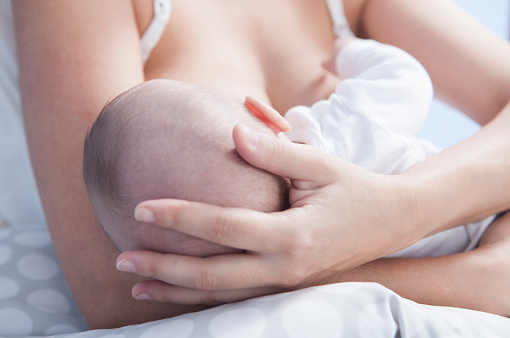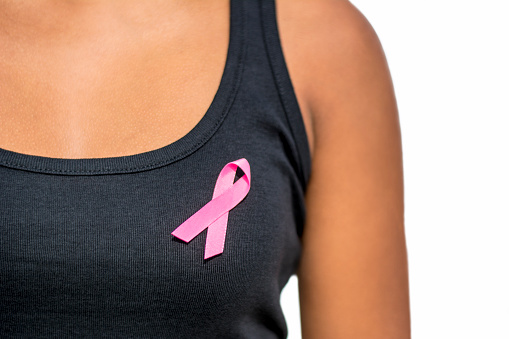- oschir.jfmed.uniba.sk - Benign breast disease
- solen.sk - Breast cancer and quality of life of women
- solen.sk - Breast cancer in pdf
- wikiskripta.eu - Breast tumours
- wikiskripta.eu - Benign breast disease
A lump in the breast: what can it mean if it is swollen or painful?

Fear shouldn't overshadow the importance of screening. Although not every lump in the breast means breast cancer.
A lump in the breast is a health concern for any woman, and especially a breast concern, especially if it is large or painful.
Not every lump in the breast is a sign of cancer. But remember the rule:
A professional examination is important and can save your health and your life.
+ Don't forget to get regular breast self-exams.
Breast cancer is one of the leading causes of cancer deaths in women worldwide.
Sources report that its incidence is still rising. On the other hand, it is important to mention that the success rate of treatment is 90 to 100%.
In the USA, one in eight women will get breast cancer.
In Europe, approximately one in nine women will get breast cancer.
In the past, women after the age of 60 were most at risk, but nowadays it is also found in large numbers in young women. And women aged 25 to 45 are no exception.
Why is this so?
The blame is attributed to a number of risk factors that combine internal and external factors.
The literature states: approximately 80% of the findings of lumps and swellings in the breast do not have a malignant basis.
In spite of this positive information, it is not advisable to neglect visiting a specialist and diagnosis. This is effective nowadays.
Remember: Early detection and early treatment increases the success rate of malignant cancer treatment.
You ask:
What does a swollen mammary gland or a painful and large lump in the breast mean?
Is a swollen mammary gland before or during ovulation, menstruation, or breastfeeding a problem?
Can a breast lump occur in children?
What does a hard or mobile lump mean?
A painful, large swollen lump in the breast?
Most of these swellings are not a serious problem. There may be a few benign (non-malignant) formations within the breast.
It can be an inflammation, a harder fatty lump, a soft cyst.
An innocent and insignificant lump that only responds to hormonal fluctuations during ovulation or menstruation.
It is common for the breasts to undergo changes in the period before ovulation or menstruation. They may be tight, enlarged and the lumps in them may behave in the same way. After the cycle ends after menstruation, they subsequently disappear.
Non-malignant forms of breast disease with the presence of a lump
Breasts undergo various changes throughout life. Women observe and feel them sensitively.
1. Breast cysts are common
These are fluid-filled sacs. They can be small or larger, appearing in one or even both breasts. The presence and size of cysts is also influenced by hormone levels.
Sometimes they hurt, sometimes a woman does not even notice them. The fact that they are present and painful is not related to cancer.
Most of the time, asymptomatic microcysts are present.
To a lesser extent, they grow to a larger size.
Women then find a mass in their breast that has:
- regular in shape
- good demarcation
- smooth surface
- is mobile under the skin
- it can be sensitive to touch
In the literature, this phenomenon is also referred to as fibrocystic mastopathy.
Aspiration puncture under ultrasound can be used to puncture the cyst and suction out its contents.
If the contents are thickened, it is necessary to remove it surgically.
Partial diagnosis can be made during puncture.
Fibrocystic disease (dysplasia) is a form of cystic transformation of the mammary gland into connective tissue that replaces functional tissue. The result is the formation of cysts. The manifestation is a distinctive palpable finding on the breast.
2. Fibroadenoma
Fibroadenoma (abbreviated FA) is the most common form of breast cancer. It is reported to affect almost 10-20% of women. It mainly affects young women between 15 and 35 years of age.
It is multiple and occurs in both breasts. Its growth and enlargement is influenced by changes in hormone levels during pregnancy, lactation and menopause.
For example.
In some cases, it can grow to a size where it deforms the shape of the breast. This is already an indication for surgical removal.
3.
An adenoma can affect several sites of the breast and mammary gland. It usually occurs during pregnancy, during the six-week period and during a woman's reproductive age.
4. Lipoma or atheroma.
Lipoma is caused by the accumulation of fat cells. It is usually single, semi-solid and well circumscribed. It is often the source of difficulty.
An atheroma is also a cyst which arises from the accumulation of sebum. The cause of its formation is a blockage of the duct of the sebaceous gland.
5. Abscess
Abscess is also one of the possibilities. In this case, it is an infected sac. The basis is inflammation, which is manifested by swelling, swelling, redness of the skin in the surrounding area.
It is hard, as it is filled with pus. The skin on its surface may be tense, shiny and warm.
In addition to the local symptoms, general flu-like symptoms may occur. Fatigue, weakness, fever and even fever may occur.
Early examination and treatment are important to prevent the inflammation from spreading through the tissues and endangering the breast and the health of the nursing mother.
6. Breast inflammation
Breast infections very often occur during breastfeeding.
The cause is injury to the nipple and infection.
Mastitis = inflammation of the breast.
Infection occurs mainly with the bacterium Staphylococcus aureus (golden staph).
This type of inflammation is typical for the first 2 to 3 weeks of breastfeeding and lactation (breastfeeding = milk production).
Puerprenium = the period of six months, the postpartum period.
The breast is red, painful, swollen. Pus may ooze from the nipple. The risk is the formation of an abscess.
The risk of breast inflammation in breastfeeding mothers is mainly:
- improper breastfeeding and pumping technique
- incorrect technique of attaching the newborn, the baby to the breast
- incomplete emptying of milk from the end of the milk ducts
- short intervals between breastfeeding
- transmission of infection (bacteria) by hands
- maternal exhaustion
Mastitis also occurs outside the period of six months of childbirth and breastfeeding. Infection results from the introduction of skin microbes into the ducts of the mammary gland.
It happens during sports activities, breast injuries, careless sexual stimulation. The current state of a woman's immunity, exhaustion, viral illness and other underlying diseases such as diabetes (weakened immunity) are also important.
7. Periductal mastitis
Furthermore, the term periductal mastitis syndrome is also mentioned in breast inflammation.
This is an inflammation of the milk ducts, which arises from the thickening of secretions that subsequently cause blockage. Secondary infection occurs.
Various factors predispose to this problem, including smoking, vitamin A deficiency, as well as congenital defects of the nipple.
8. Intraductal papilloma
Intraductal papilloma is a small formation that grows from the epithelium of the milk duct. It is behind the pathological discharge from the nipple. The secret can also be bloody if there is an injury to the blood vessels that supply it.
9. Phyloid tumour
A phyloid tumour is a benign tumour that affects young women and women in the reproductive period. It grows to a large size. The risk is the transition to a malignant form.
10. Hamartoma
Hamartoma is one of the rare tumours. It is often referred to as adenolipoma or fibroadenolipoma, which describes its composition of fibrous, glandular and adipose tissue.
It is painless, well circumscribed, small.
11. Granulosa cell tumour
Granulosa cell tumor is also rare. It originates from Schwann cells of the peripheral nervous system. It usually affects areas of the body such as the head, neck. And rarely it may affect the breast.
It can resemble cancer because it is firmly attached to the skin or other structure of the breast. It can also form a superficial ulcer, an open wound. A rare risk is the occurrence of a malignant type.
12. Pseudoangiomatous stromal hyperplasia of the breast
Pseudoangiomatous stromal hyperplasia of the breast (PASH) is also a rarer finding. It occurs in women in the reproductive period and has a hormonal basis. It manifests as a growth, usually in one breast.
13. Diabetic fibrous mastopathy
Occurs in women with type I diabetes mellitus. It is a rare form of tumor. It may be in the form of a single lump, but also multiple. It has an indistinct border and is solid.
14. Fat necrosis
It results from damage to fat cells, causing them to die. The basis is trauma and damage, and an example is blunt trauma to the breast or surgery, but also radiotherapy.
Malignant breast tumour - cancer
Worldwide, breast cancer is the most common malignant cancer in women.
About 50% of women develop metastases after initial treatment.
It affects both women and men.
It is reported that about 90% of tumours originate in the mammary gland and milk ducts.
The growth of the cancer can be slow and subtle. However, there are also aggressive forms that increase in size within days.
Cancer spreads through surrounding tissue and to regional lymph nodes.
Pain is not present in the early stages. It only becomes associated later, when the tumour is a source of tension and oppression.
Symptoms of cancer may include:
- a lump, a nodule
- a change in the colour of the breast skin
- breast enlargement
- retraction of the nipple, which can also occur with other nipple and breast disorders
- brown or bloody discharge from the nipple
- skin changes and discoloration of the nipple, areola, scales
- wrinkled breast skin, indentation, dimpling of the skin, resembling an orange
- pain and tightness in the breast, may not be present in the early stages of cancer
- enlargement of nodes around the breast, in the armpit, neck and above the collarbone
Why does it arise, you ask?
We don't know. That's why we don't know effective prevention.
However, the negative effect is attributed to factors such as:
- inappropriate lifestyle
- obesity, overweight
- smoking, alcoholism
- stress
- exposure to radiation and chemicals
- family occurrence, especially in mother, sister, daughter
- age over 50
- late menopause after age 45
- hormonal influence
- women who have not given birth
- pregnancy after the age of 30
- early onset of menstruation, before the age of 12 (menarche)
- previous breast cancer
- long-term hormonal treatment, probably
Several names are associated with the term breast cancer, such as ductal carcinoma in situ, infiltrating ductal carcinoma, lobular carcinoma, ductal carcinoma or Paget's carcinoma, among others.
For more information, read the article.
Can a lump occur in children or babies?
In young babies during the breastfeeding period, breast glands can enlarge, even in the first few weeks after birth.
This effect is brought about by hormonal influence, i.e. breastfeeding and the intake of breast milk.
After breastfeeding has stopped, the condition changes.

Subsequently, problems may occur in girls at puberty when the mammary glands are growing. Even young girls may experience a similar problem at the time of hormonal changes during ovulation and menstruation.
Of course, monitoring and examination is always necessary, especially if there are breast lumps, nipple discharge, breast anomalies and deformities, noticeable size difference or pain.
Breast self-examination or is it possible to distinguish a harmless lump from a carcinoma?
You ask:
Is it possible to tell a harmless lump from cancer?
It's difficult at home. That's why a specialist examination is necessary. This includes a mammogram or ultrasound of the breasts (and others) in addition to a gynaecological examination.
Why?
Sometimes even a large painful lump in the breast does not indicate cancer, and conversely, even a small painless form can have a malignant basis.
Examples of non-specific differences may be:
- is it a mobile lump with a smooth round shape?
- is such a lump sliding freely under the skin?
- in cancer, there is fixation to the surrounding area (not freely manipulable on palpation)
- does the pain in the breast occur before ovulation or menstruation and subside afterwards?
- difference in cancer where pain may not be present in the first stage
- and then the pain is permanent due to the oppression of the surrounding area.
- has there been significant enlargement of one breast?
- does the nipple and areola change shape?
- is there a change in the colour of the skin of the breast?
- have the nearby regional nodes enlarged?
What is breast self-examination?
It is performed by palpation, and of course by sight. The woman, the girl, palpates the breast and detects the presence of swellings, deformities and other breast characteristics.
The important thing is:
- for women over 18 years of age, it should be carried out once a month
- preferably on the 3rd or 4th day after the end of menstruation, so that the greatest hormonal changes can pass
- post-menopausal women every month, for example on the first day of the month
How to do it?
- the woman stands in front of a mirror, observes the shape and size of her breasts
- hands are in line with the body, then raises the arms above the head
- followed by a sitting, lying down examination
- symmetry of movement and breathing is also important
- looking from the front
- side view
- first grasp the breast between both hands, applying gentle pressure and gliding
- then palpate the right breast with the left hand and vice versa
- while raising the hand on the side of the breast under examination and twice with the hand relaxed beside the body
- palpation of the breast with the bellies of the fingers, from top to bottom
- stroking and circular movements
- gently pressing on the nipples and observing the pathological discharge
- after palpating the breasts, check the chest, armpits, above the collarbone and neck, looking for lymph node enlargement
It is important to observe:
- shape and symmetry
- changes in the size of one breast
- changes in colour
- presence of swellings, new nodules
- wrinkled skin and orange skin
- pulling the skin and nipple inwards
- discharge from the nipple
- nipple and areola changes, for example nipple retraction
Remember:
Not every change is a sign of cancer.
But going for a specialist examination if you have a suspicious finding is a must.

Samovyšetrenie prsníkov - Trenčianska univerzita Alexandra Dubčeka v Trenčíne
Diseases with symptom "Bulges in the breast"
Interesting resources










